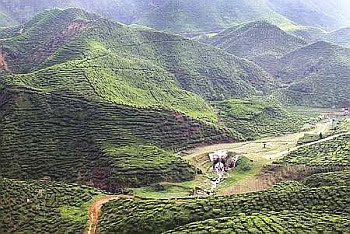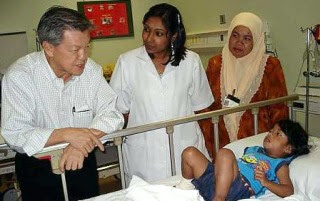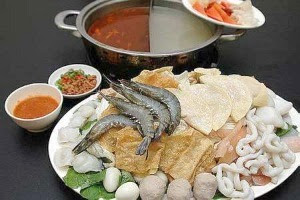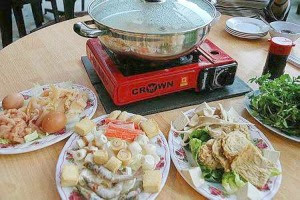Sunday August 26, 2007
By Helen Ong
Cameron beckons with its calming scenery, beautiful gardens and farms.
THERE’S a good reason why the Cameron Highlands is one of Malaysia’s most popular resorts. In fact, there are plenty of good reasons.
The new road from Simpang Pulai makes for quite a pleasant drive, and despite what people say about global warming and higher temperatures there, the cool weather is obviously the greatest draw.
During the day, it is sunny but pleasantly mild, and warm enough to go about in shorts and T-shirt, although a cardigan on standby is always advisable.
 Surreal English experience: You could be in Surrey.
Surreal English experience: You could be in Surrey.It definitely cools down when the sun sets, but the low temperature and high altitude will give you a good night’s rest. However, do have your bath during the day when the ambient temperature is still comfortable enough to shed your clothes.
Cameron Highlands produces a lot of our vegetables not just because of its altitude but also because of its high rainfall. Chances are it will pour when you are there, so don’t forget your waterproofs or umbrella.
The beautiful scenery and lovely houses like the newly-refurbished Cameron Highlands Resort and Ye Olde Smokehouse will transport you to Shakespearean times in Stratford-upon-Avon with their black and white mock-Tudor buildings.
Combine the first two and you will see why it’s very pleasant even if you do nothing more than go for a gentle stroll after a meal, or a more energetic hike around the golf course – the cool weather will ensure you don’t get hot under the collar, (literally, if not metaphorically). The 18-hole public golf course is relatively cheap, and although there are no buggies, the walk is not arduous.
 Panoramic: Visitors to the Cameron Bharat Tea House located on the road side between Tanah Rata and Ringlet in Cameron Highlands will be treated to this breathtaking view of the plantation’s rolling hills and manicured tea bushes.
Panoramic: Visitors to the Cameron Bharat Tea House located on the road side between Tanah Rata and Ringlet in Cameron Highlands will be treated to this breathtaking view of the plantation’s rolling hills and manicured tea bushes.There are also surprisingly many other things to see and do, like the Cactus Farm, Rose Centre, Butterfly Farm, etc. At the Boh Plantation in Sungai Palas, learn about how it was started by Englishman J.A. Russell and visit the original 1920s factory. Enjoy the calm scenery from the viewing platform – tea, tea, everywhere – and purchase traditional and flavoured varieties at their gift shop.
Take the opportunity to visit some vegetable and flower farms on the outskirts of town – the greens (and greens, yellow, reds and other colours) are amazing. When you tuck into a crunchy sweet corn plucked straight off the plant, you’ll understand why it got the name in the first place.
According to Kodimani, who runs the Kasihmanis Strawberry Farm, one of the oldest, just outside Brinchang, there are now many places which produce this delicious temperate fruit.
 Luscious: Strawberries galore!
Luscious: Strawberries galore!Some invite you to “self pluck” (sic), and enjoy a host of by-products, from homemade jams to milk shakes and ice cream. They are so plentiful that many restaurants offer fresh strawberry juice, thick and delicious, which makes a pleasant change from orange or apple.
Every other shop seems to be cashing in on this speciality. Apart from jam, you can buy strawberry pillows, balls, balloons, toys, mugs and jugs ? the list is endless. Some are cute, others a bit kitsch and a few are downright tacky, but there’ll be something to please everyone back home!
And if you go to the Pasar Malam, held on Friday and Saturday nights, vegetables and flowers are abundant and cheap. Go near closing time and a big bag of mixed vegetables will cost just RM10.
An important consideration is food, of course, and Steamboat is popular as it is ideal for the weather, and there are many restaurants which offer this – just take a stroll along Brinchang and you’ll see.
However, there are other things on offer, from Uncle Chow’s in Tanah Rata which has a good selection of local specialities to many other cuisines.
 Cheery: A burst of sunshine from yellow chrysanthemums.
Cheery: A burst of sunshine from yellow chrysanthemums.Continue the slightly surreal English experience with classic ‘Afternoon Tea and Scones’ which are available everywhere ? with strawberry jam, of course.
It’s a wonderful place to go for some R&R, but don’t even attempt it during public or school holidays, as locals were happily recounting tales of four-hour long traffic jams stretching from just Kampung Raja to Brinchang. Parking, accommodation and restaurants become scarce resources and command much higher prices.
It’s even more enjoyable when there’s a group of you. As the night sets in, it’s very cosy to draw the curtains, have a few drinks, for medicinal purposes only, of course, play mahjong or some other games. If you’re looking for some away-time, then head for Cameron Highlands. -- Sunday Metro.









